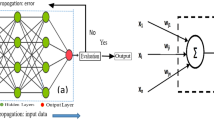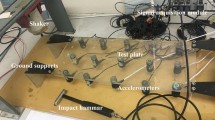Abstract
Structural health monitoring (SHM) is a long standing problem in the area of aircraft structures. Recently data-driven SHM technique using machine learning (ML) algorithms are being explored extensively. The benefits of ML-based SHM methodologies include capabilities to handle structures of higher complexities, varying environmental and operational conditions, and potential for online monitoring. In this work, artificial neural network (ANN) is implemented for damage detection using Lamb response of thin aluminium plate. The Lamb wave responses are obtained both experimentally and through finite element (FE) simulation using ABAQUS. The efficiency of ANN model strongly depends on proper selection of input features from the Lamb wave responses. Here, an automated feature extraction tool, namely, Time Series Feature Extraction on basis of Scalable Hypothesis tests (Tsfresh) is used. Next, feature selection is performed, which involves elimination of irrelevant or less important features. Tsfresh also automates this process by comparing the features against output variables. The proposed ANN model with the automated feature selection predicts the presence of damage with 100% accuracy.



Similar content being viewed by others
References
An D, Kim NH, Choi J-H (2015) Practical options for selecting data-driven or physics-based prognostics algorithms with reviews. Reliabil Eng Syst Saf 133:223–236
Asokkumar A, Venkat RS, Boller C (2019) Identification of key performance indicators for shm in structures of increasing complexity based on artificial neural networks
Atashipour SA, Mirdamadi HR, Hemasian-Etefagh MH, Amirfattahi R, Ziaei-Rad S (2013) An effective damage identification approach in thick steel beams based on guided ultrasonic waves for structural health monitoring applications. J Intell Mater Syst Struct 24(5):584–597
Califano A, Chandarana N, Grassia L, D’Amore A, Soutis C (2020) Damage detection in composites by artificial neural networks trained by using in situ distributed strains. Appl Compos Mater 27(5):657–671
Christ M, Braun N, Neuffer J, Kempa-Liehr AW (2018) Time series feature extraction on basis of scalable hypothesis tests (tsfresh-a python package). Neurocomputing 307:72–77
Gardner P, Barthorpe RJ, Lord C (2016) The development of a damage model for the use in machine learning driven shm and comparison with conventional shm methods. In: Proceedings of the international conference on noise and vibration engineering, pp 3333–3346
Giurgiutiu V, Cuc A (2005) Embedded non-destructive evaluation for structural health monitoring, damage detection, and failure prevention. Shock Vib Digest 37(2):83
Khan S, Yairi T (2018) A review on the application of deep learning in system health management. Mech Syst Signal Process 107:241–265
Kingma DP, Ba J (2014) Adam: a method for stochastic optimization. arXiv:1412.6980 (arXiv preprint)
Lu Y, Ye L, Su Z, Zhou L, Cheng L (2009) Artificial neural network (ann)-based crack identification in aluminum plates with lamb wave signals. J Intell Mater Syst Struct 20(1):39–49
Melville J, Alguri KS, Deemer C, Harley JB (2018) Structural damage detection using deep learning of ultrasonic guided waves. In: AIP conference proceedings, vol 1949, p 230004. AIP Publishing LLC
Mitra M, Gopalakrishnan S (2016) Guided wave based structural health monitoring: a review. Smart Mater Struct 25(5):053001
Neves AC, Gonzalez I, Leander J, Karoumi R (2017) Structural health monitoring of bridges: a model-free ann-based approach to damage detection. J Civ Struct Health Monit 7(5):689–702
Nick W, Asamene K, Bullock G, Esterline A, Sundaresan M (2015) A study of machine learning techniques for detecting and classifying structural damage. Int J Mach Learn Comput 5(4):313
Qian C, Ran Y, He J, Ren Y, Sun B, Zhang W, Wang R (2020) Application of artificial neural networks for quantitative damage detection in unidirectional composite structures based on lamb waves. Adv Mech Eng 12(3):1687814020914732
Raghavan A (2007) Guided-wave structural health monitoring. PhD thesis
Rai A, Mitra M (2021) Lamb wave based damage detection in metallic plates using multi-headed 1-dimensional convolutional neural network. Smart Mater Struct 30(3):035010
Rai A, Mitra M (2021) A hybrid physics-assisted machine-learning-based damage detection using lamb wave. Sādhanā 46(2):1–11
Ramadas C, Balasubramaniam K, Joshi M, Krishnamurthy CV (2011) Interaction of lamb mode (ao) with structural discontinuity and generation of “turning modes’’ in a t-joint. Ultrasonics 51(5):586–595
Sen D, Nagarajaiah S (2018) Data-driven approach to structural health monitoring using statistical learning algorithms. Mechatronics for cultural heritage and civil engineering. Springer, Berlin, pp 295–305
Smarsly K, Hartmann D (2007) Artificial intelligence in structural health monitoring. In: Proceedings of the third international conference on structural engineering, mechanics and computation, Cape Town, South Africa, vol 10, p 2007
Staszewski WJ (2005) Ultrasonic/guided waves for structural health monitoring. Key engineering materials, vol 293. Trans Tech Publ, Switzerland, pp 49–62
Su Z, Ye L (2005) Lamb wave propagation-based damage identification for quasi-isotropic cf/ep composite laminates using artificial neural algorithm: Part i-methodology and database development. J Intell Mater Syst Struct 16(2):97–111
Ying Y, Garrett JH Jr, Oppenheim IJ, Soibelman L, Harley JB, Shi J, Jin Y (2013) Toward data-driven structural health monitoring: application of machine learning and signal processing to damage detection. J Comput Civ Eng 27(6):667–680
Author information
Authors and Affiliations
Corresponding author
Additional information
Publisher's Note
Springer Nature remains neutral with regard to jurisdictional claims in published maps and institutional affiliations.
Rights and permissions
About this article
Cite this article
Prajapati, K.K., Rai, A. & Mitra, M. Lamb Wave-Based Damage Detection Using Artificial Neural Network and Automated Feature Extraction. Trans Indian Natl. Acad. Eng. 7, 1009–1016 (2022). https://doi.org/10.1007/s41403-022-00342-2
Received:
Accepted:
Published:
Issue Date:
DOI: https://doi.org/10.1007/s41403-022-00342-2




